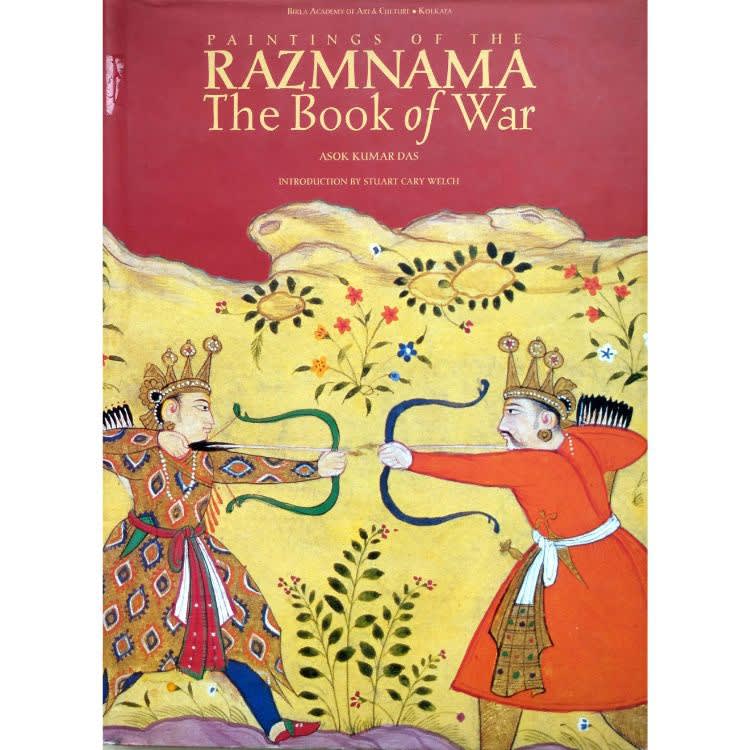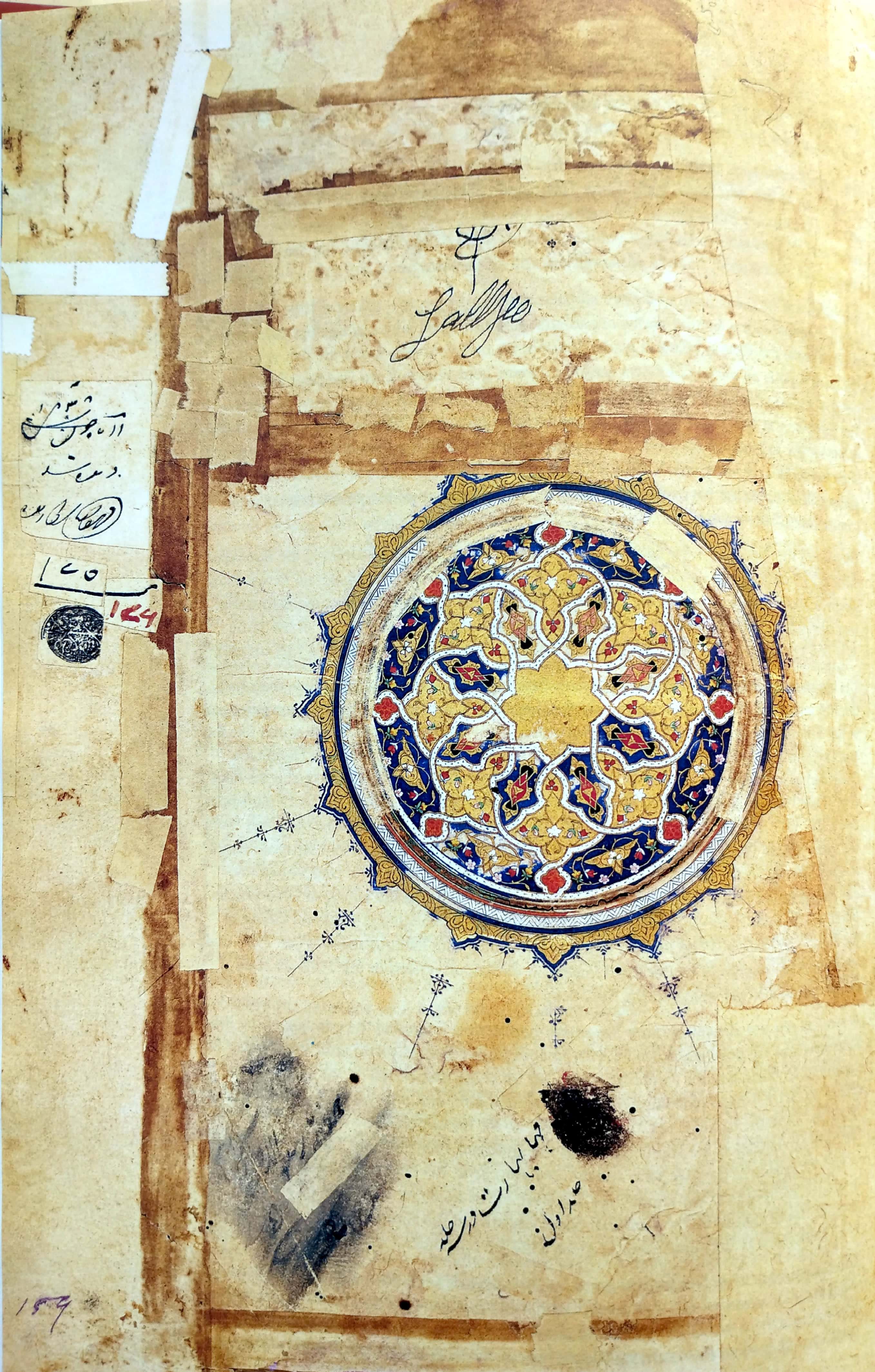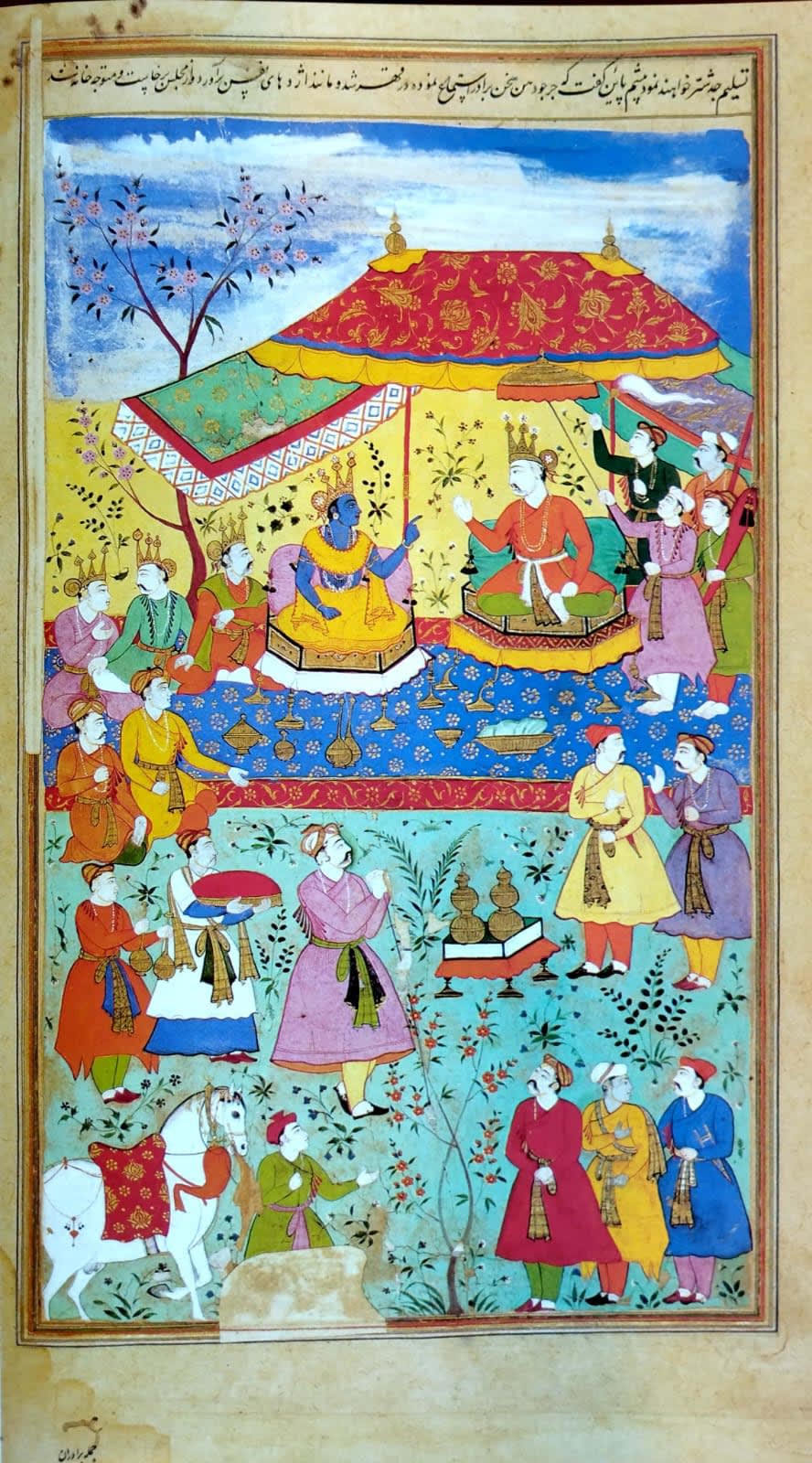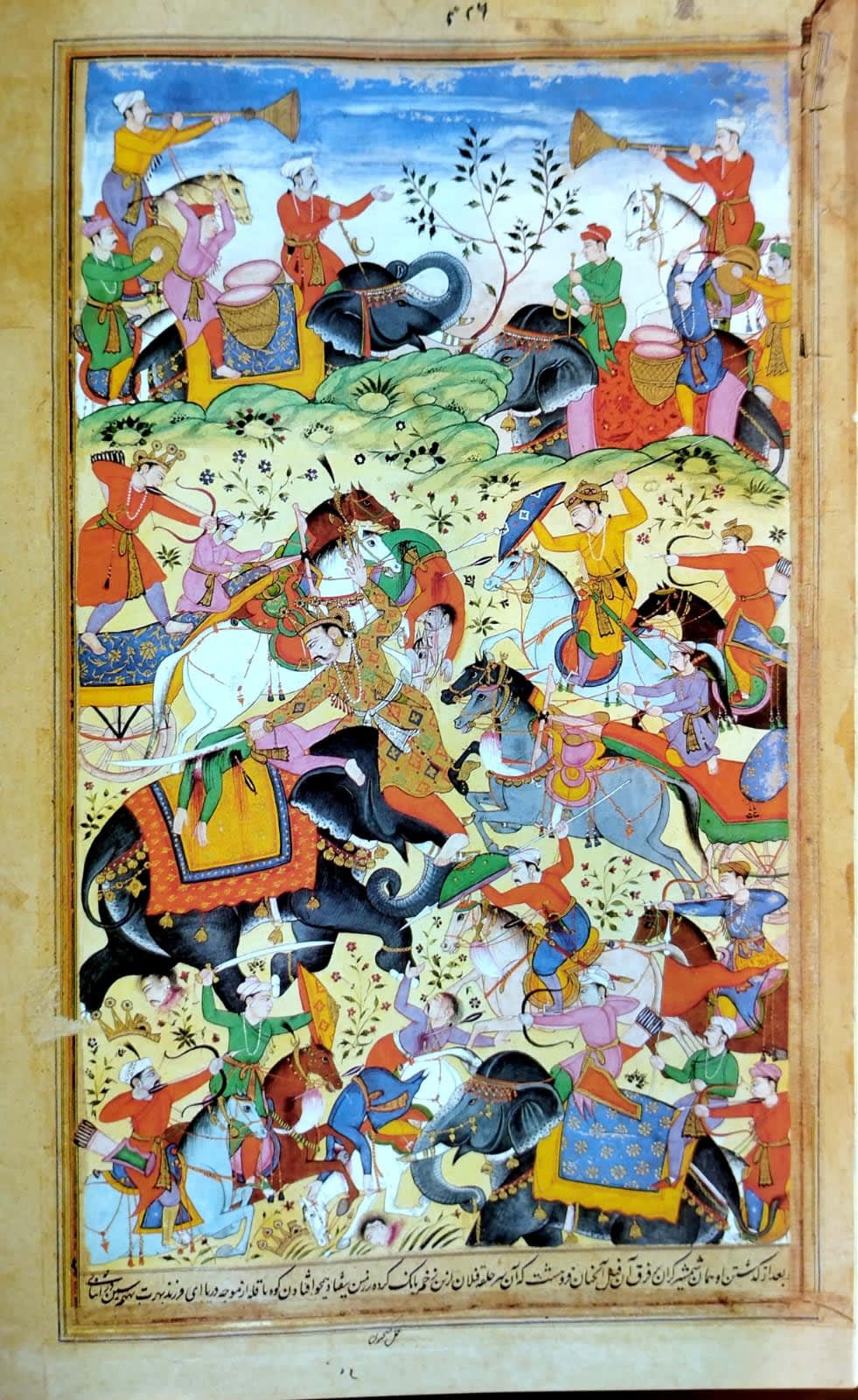
The Mughals may have historically been the wild nomadic plunderers of Mongolia, but in India, they unfurled a rich culture of artistry and aesthetics. From Babur to Aurangzeb, they all attempted to exalt various forms of creative works — poetry, painting, dance, music, architecture, and courtly history writing. As we know, Jalaluddin Muhammad Akbar, the third Mughal emperor, was a great patron of art. Akbar's interest in books and paintings was not just to maintain a family tradition. While collecting and commissioning manuscripts, he aimed to expand the horizons of his knowledge and its dissemination among the courtiers and subjects. In Ain-i-Akbari, Abu'l-Fazal, Akbar’s court historian, gives us a valuable glimpse of Akbar's imperial studio, the Tasvir Khana. In this studio, more than a hundred artists and painters worked together under the supervision of two Persian painters, Mir Sayyid Ali and Abdus Samad. A new miniature style emerged from the amalgamation of the elements of the Indian and Islamic worlds. Ornamental designs and vivid colours add to the magnificence of the paintings, along with the realistic details.
Akbar’s imperial policies were based on the attempt to incorporate non-Muslims into royal administration and various other positions like cooks, scribes, artists, etc. In 1575, Akbar began constructing the Ibadat Khana, the House of Worship, where he brought together theologians and scholars of different religions who presented their religious beliefs before him. These discussions and debates triggered him to promulgate his new faith in 1581— the 'Din-i Ilahi'—a coalescence of diverse religious beliefs and practices.
The painters in Akbar's atelier had previously prepared illustrated copies of Qissa-i Amir Hamza, Gulistan, Shahnama, Tutinama, among many other Persian classics. Maktab Khana, the imperial translation bureau, was constructed at Akbar’s capital Fatehpur Sikri in 1574. Here, the translation of a range of Sanskrit texts like the Rajtarangini and the Ramayana had been completed. Akbar believed these translations would end the rigid divide between Hindus and Muslims. It would spread the real spirit of the concerned religions, removing the interpretations of mullahs and priests, which often counter to the texts.
During this period of intra-religious discourse, the translation of the Mahabharata into Persian, known as the Razmnama (the Book of War), began. It was completed between 1582-84. Akbar invited well-known Sanskrit scholars from different parts of the empire and selected some of his learned courtiers to fuel the translation process. Naqib Khan, the theologian; Sheikh Sultan Thanesari, an eminent philosopher; Mulla Sheri, the court poet and the well-known historian Abdul Qadir Badauni were some of them. Initially, concise explanations of the unimaginably vast Sanskrit text were prepared, then sketched out in Persian, and finally put into exquisite literary form.
Three well-known copies of the Razmnama survive to date. The first and oldest one was prepared immediately after the translation was completed and survives intact in the Maharaja Sawai Man Singh II Museum in Jaipur's City Palace. This imperial copy, the Jaipur Razmnama, has 168 full-page illustrations. They generally contain a short description and the name of the artist in the nasta'liq script, of which as many as 52 names have been identified. Painted in gouache on paper, these miniatures are among the first examples of the Indo-Persian painting style. The second oldest known copy of the Razmnama was completed between 1598 and 1599. Interestingly, there are significant differences between the illustrations that adorn the two copies. While the former, the imperial copy, was incredibly elaborate and extravagant, the latters’ were somewhat low-key, probably due to constraints of time or remuneration.

Circular Shamsa, First Volume, Razmnama, Birla Academy
The third copy of Razmnama was completed in 1605 and is the only one complete with 81 deluxe miniatures. It is housed in the Birla Academy of Art and Culture, Kolkata. Unfortunately, the name of the project’s leading artist is not known. The Birla Razmnama is a three-volume manuscript, the folios being 40.7 × 27.3 cm in size. The first volume contains folios 1 to 259 and comprises the Adi, Sabha, Vana, Virata, Udyoga and Bhisma parvas and 41 illustrations. The second one has folios 260 to 512, including the Drona, Karna, Salya, Samptika, Stri and Santi parvas and 25 miniatures. The third and last one consists of folios 513 to 629 and has the Anusasana, Asvamedhika, Mausala, Mahaprasthana and Swargarohana parvas and only 15 illustrations. The first volume opens with a circular shamsa or sunburst design in gold, blue and red. A shikasta inscription below it reads — ‘ Mahabharata in three volumes, this is the first volume.’ The brilliant colours and the extensive use of gold in the illustrations of the Birla Razmnama are typical of Mughal miniatures. At the same time, the manuscript reveals an amalgamation of contemporary Mughal style with plenty of local variations.
A common feature of these miniatures is their simple margins in contrast to the richly decorated borders — hashiya — typical of Mughal art. The large number of figures in each illustration brings out the colossal nature of the epic. The effective depiction of a Hindu text through Islamic artistic elements is worth noticing. Let us take a closer look at three out of the eighty-one miniatures of the Birla Razmnama.
Folio no. 15 depicts one of the most crucial scenes of the Mahabharata, Yudhishthira playing a game of dice with Duryodhana's crafty uncle, Shakuni. As we know, eventually, he would encounter a devastating loss. In this painting, several scenes have been depicted within a single frame, a device commonly used in the manuscript. The two key players, as well as Kurava nobles, elders and invited kings, are sitting on the ground dotted with delicate flowering shrubs. They witness the turmoil, eventually leading to Draupadi’s insult by Dussasana. At the bottom, the final consequence of the unlawful game is shown — the long exile of the five Pandavas along with Draupadi. The soft green background indicates the Pandavas’ new abode, the Kamyak Forest.

Krishna at Kaurava Court, Razmnama, Birla Academy
Folio no. 35 illustrates Krishna’s visit to the Kaurava court. In an atmosphere where war appeared inevitable, Krishna conversed with Duryodhana to persuade the Kauravas to give back to the Pandavas their rightful share of the kingdom and ensure peace. Apart from the nobles and courtiers, the painting shows several attendants and retainers, generally present in standard Mughal court scenes. All of them except Krishna are garbed in Mughal court costumes.

Death of Srutayu, King of Kalinga, Razmnama, Birla Academy
Folio no. 40 portrays a crucial event of the 18-day-long battle of Kurukshetra, the killing of Srutayu, the King of Kalinga, by Bhima. In extreme tension, Arjuna and Bhisma, Dhristyadyumna and Drona were locked in deadly combat with each other. At this point, Bhima attacks Srutayu, balancing himself on the tusk of the latter’s elephant and killing him. The pandemonium going on is effectively depicted, and interestingly, Bhima uses a Mughal- style shamshir sword to finish off his opponent.
The Razmnama stands out as a unique blend of indigenous Indian and Persian artistic styles and a testimony to the subcontinent's long tradition of Hindu - Muslim harmony.
References
- Asok Kumar Das. Paintings of the Razmnama. Mapin Publishing Pvt, 2005.
- Rice, Yael. A Persian Mahabharat: The 1598-1599 Razmnama. University of Hawai'i Press, 2010.
- Seyller, John. The Illustration of Three Razmnama Manuscripts. University of Hawai'i Press, 1985. Accessed 2014.

Sripurna Majumdar is a student of social sciences based in Kolkata. She is enthusiastic about the nuances of literature and history and also loves star gazing.